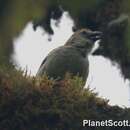Biology
(
Inglês
)
fornecido por Arkive
The remarkable feeding behaviour demonstrated by the woodpecker finch involves the use of twigs and cactus spines to push, stab or lever insects and spiders from tree-holes and crevices (3). Displaying extraordinary behavioural adaptability, this species will not only seek out a variety of different feeding implements, but will also manipulate them to make them more manageable, for example by shortening cactus spines with its bill (7). Although the woodpecker finch's use of tools enables it to access inaccessible sources of food, particularly those with the high energy content such as spider egg sacs, it incurs a significant cost by being a relatively time consuming foraging technique. Therefore, it is a behaviour most commonly exhibited by woodpecker finches in the arid zone during the dry season, when easily accessible food supplies are scarce. In contrast, during the Arid Zone wet season, and throughout the year in the Scalesia Zone, invertebrate prey are generally abundant and easily accessible, hence the woodpecker finch is more reliant on its specialised, pointed bill to probe amongst moss and bark for prey, and rarely uses tools (3).
Darwin's finches usually breed during the hot, wet season when food is most abundant. Monogamous, lifelong breeding pairs are common, although mate changes and breeding with more than one partner have also been observed. Breeding pairs maintain small territories, in which they construct a small dome-shaped nest with an entrance hole in the side. Generally a clutch of three eggs is laid, which are incubated by the female for about twelve days, and the young brooded for a further two weeks before leaving the nest. The short-eared owl (Asio flammeus), frequently preys on the nestlings and juvenile Darwin's finches, while adults are occasionally taken by Galapagos hawks (Buteo galapagoensis) and lava herons (Butorides sundevalli) (2).
Conservation
(
Inglês
)
fornecido por Arkive
The majority of the Galapagos archipelago forms part of the Galapagos National Park, a World Heritage Site. A management plan is in place for the islands, and the Ecuadorian government and non-governmental organisations are working to conserve the unique biodiversity of the Galapagos (10). More specifically, scientists at the Charles Darwin Research Station are working to improve our understanding of Darwin's finches to ensure their conservation. This includes monitoring of populations and investigating introduced diseases (8).
Description
(
Inglês
)
fornecido por Arkive
Perhaps the most famous of Darwin's finches, the woodpecker finch has attracted popular and scientific attention for its remarkable usage of tools to assist feeding (2) (3). Like the other Darwin's finches, this species has evolved a specialised beak form, enabling it to exploit a particular habitat and diet (2). In the case of the woodpecker finch, its beak is long and pointed, allowing it to probe deeply into cavities in search of food (4). Adults and juveniles both have dull, uniform, light greyish-olive plumage (5), with the only distinguishing feature being beak colouration, which changes from pink to black as this species matures (3).
Habitat
(
Inglês
)
fornecido por Arkive
The woodpecker finch is mostly found in the Scalesia Zone, a lush, humid evergreen forest dominated by the daisy tree (Scalesia pedunculata), which is found between elevations of 300 and 700 metres. This species also occurs in the lowland Arid Zone, which is dominated by deciduous trees, shrubs and cacti, but is much rarer in this habitat (3).
Range
(
Inglês
)
fornecido por Arkive
The woodpecker finch is endemic to the Galapagos Archipelago, where it occupies the islands of Isabela, Fernandina, Santiago, Pinzón, Santa Cruz, and San Cristóbal (6).
Status
(
Inglês
)
fornecido por Arkive
Classified as Least Concern (LC) on the IUCN Red List (1).
Threats
(
Inglês
)
fornecido por Arkive
Like other bird species endemic to the Galapagos, the woodpecker finch is affected by ongoing habitat destruction, invasive species, and introduced diseases, such as avian pox (8). Nevertheless, despite being uncommon in some parts of its range, the global population of this species is not considered to be small enough, nor undergoing a sufficiently significant decline, to warrant a threatened classification (9).

